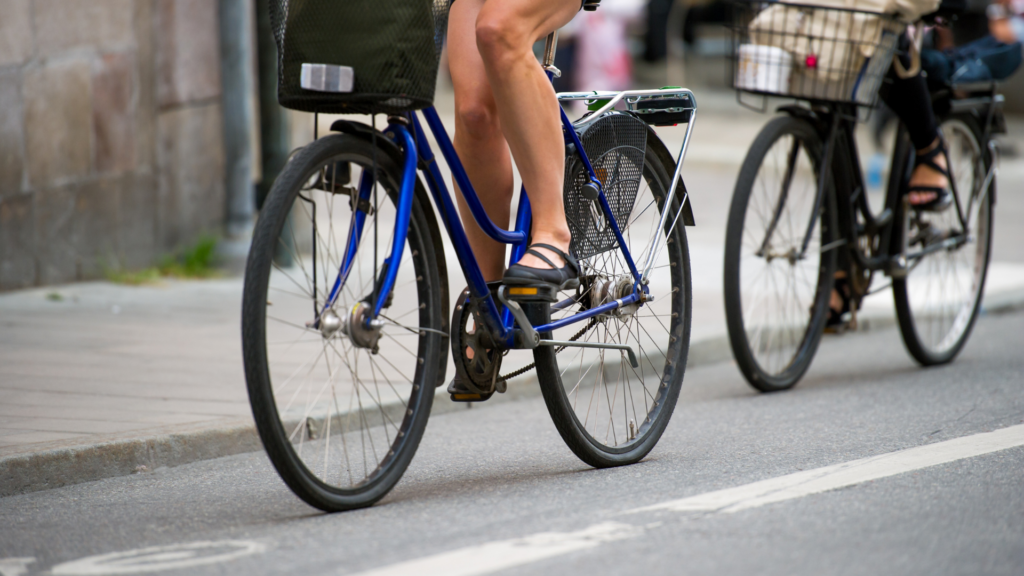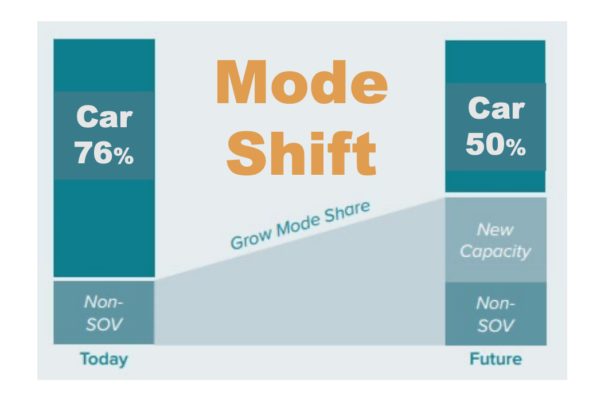CDOT proposes a “bundling” strategy for mobility projects

A woman rides her bike down the road
On Monday, August 28, Charlotte City Council met for a Business Meeting where they received an update on the Strategic Mobility Plan (SMP) from Charlotte Department of Transportation’s (CDOT) Deputy Director Ed McKinney. Several other items were on the agenda, including a housing support grant presentation and multiple public hearings, but this post will focus exclusively on the SMP presentation and update.
McKinney kicked off the presentation by reminding council members of CDOT’s Mobility Investment Blueprint that debuted in April. Instead of prioritizing the more than 2,000 identified mobility projects one by one, CDOT is proposing a “bundling” strategy that will combine several mobility projects in one small geographic area at a time, called Strategic Investment Areas (SIAs). This strategy moves beyond thinking only about congestion and aims to consider all modes (walking, biking, buses, etc.) equally. As you can see below, CDOT is working to define and prioritize these SIAs by early 2024.
City Manager Marcus Jones pointed out that the ideas in the presentation are just that: ideas. Recent examples from cities such as Boston and New York indicate that this bundling approach may be the most efficient way forward, but ultimately the strategies need to have a funding source to become a reality. Currently, the Capital Improvement Program (CIP) budget that funds mobility infrastructure is dramatically insufficient for the plans outlined in this presentation.
For example, the city’s 2022 CIP bond allocated close to $50M for sidewalks and $17M for Vision Zero. In contrast, the proposed allocations for the 2024, 2026, and 2028 CIP bonds combined would provide just $57M for sidewalks and $12M for Vision Zero. Similarly, funding for the bicycle program remains low at $8M every two years which will not allow us to build a safe, connected bicycle network for many decades. This radical reduction in fund allocation is due to the dramatic increase in supply and labor project costs and a slightly reduced overall bond capacity over the next three cycles (from $226M to $210M) of which $137M will be invested in two intersection improvements and two new road projects. As a result, there is not nearly enough funding in the CIP budget for the bicycle and pedestrian infrastructure and making our streets safer for all.
City council response
Here are some of the reactions to the proposed bundling strategy and future CIP allocations.
Ed Driggs:
- “We all need to stay focused on the process of moving our mobility plan forward, our Connect Beyond plan, the sales tax revenue, because that is where the money comes from that would enable us to actually implement some of these things.”
- “What we have right now… is a little academic if all we’re talking about is the CIP. It just doesn’t buy much.”
James Mitchell:
- “I’m struggling because I think we are nowhere near articulating our mobility vision to our citizens”
- “We have limited dollars so how many circles [bundled projects] are we really going to connect?”
Victoria Watlington:
- “We’ve got to confront the idea that as we continue to grow our infrastructure needs seem to be outpacing our revenue.”
- “As we think about the plan moving forward it has to be inclusive of all options. It cannot just hinge on residents of Charlotte-Mecklenburg footing the bill for a transportation system that is regional in nature.”
Mayor Vi Lyles:
- “The only other thing to do is look at what the federal government is going to allow, and we have to look at that pretty quickly.”
- “Without a revenue source, we are going to fall without any improvement except for what we generate on our own and that’s just not going to be feasible for one of the fastest-growing cities.”
Mayor Pro Tem Braxton Winston:
- “I think we do have a succinct vision for mobility plans and we should remember that. It’s the 50/50 mode-share for all trips within Charlotte and that’s something that council has adopted…that we need to work towards.”
Through investment in pedestrian, bicycle, and public transportation infrastructure, Charlotte aims to reduce the percentage of trips taken by a single occupancy vehicle (SOV) to 50% by 2040. Source: City of Charlotte Department of Transportation
Our take
We agree with these comments from Mayor Lyles and Council Members. It is clear that the funds available through bonds alone fall far short of our growing city’s mobility needs. Without much larger revenue for transportation investments, it will be impossible to reach our goal of reducing the percentage of trips taken by driving alone to 50% by 2040.
We urge elected officials both on Charlotte City Council and across our region to aggressively pursue additional, significant funding sources. Without sidewalks, pedestrian crossings, bike lanes, and safe, reliable, convenient public transportation, our city cannot grow equitably or sustainably. Our neighbors deserve mobility infrastructure that keeps pace with housing and development growth.
Watch the meeting recording here.
Thanks for reading!
As a nonprofit, community support is essential for us to keep doing what we do – including providing free articles like this. If you found this article helpful, please consider supporting Sustain Charlotte.
Want to stay in the loop? Subscribe to our weekly newsletter and follow us on Instagram, Facebook, and Twitter.



